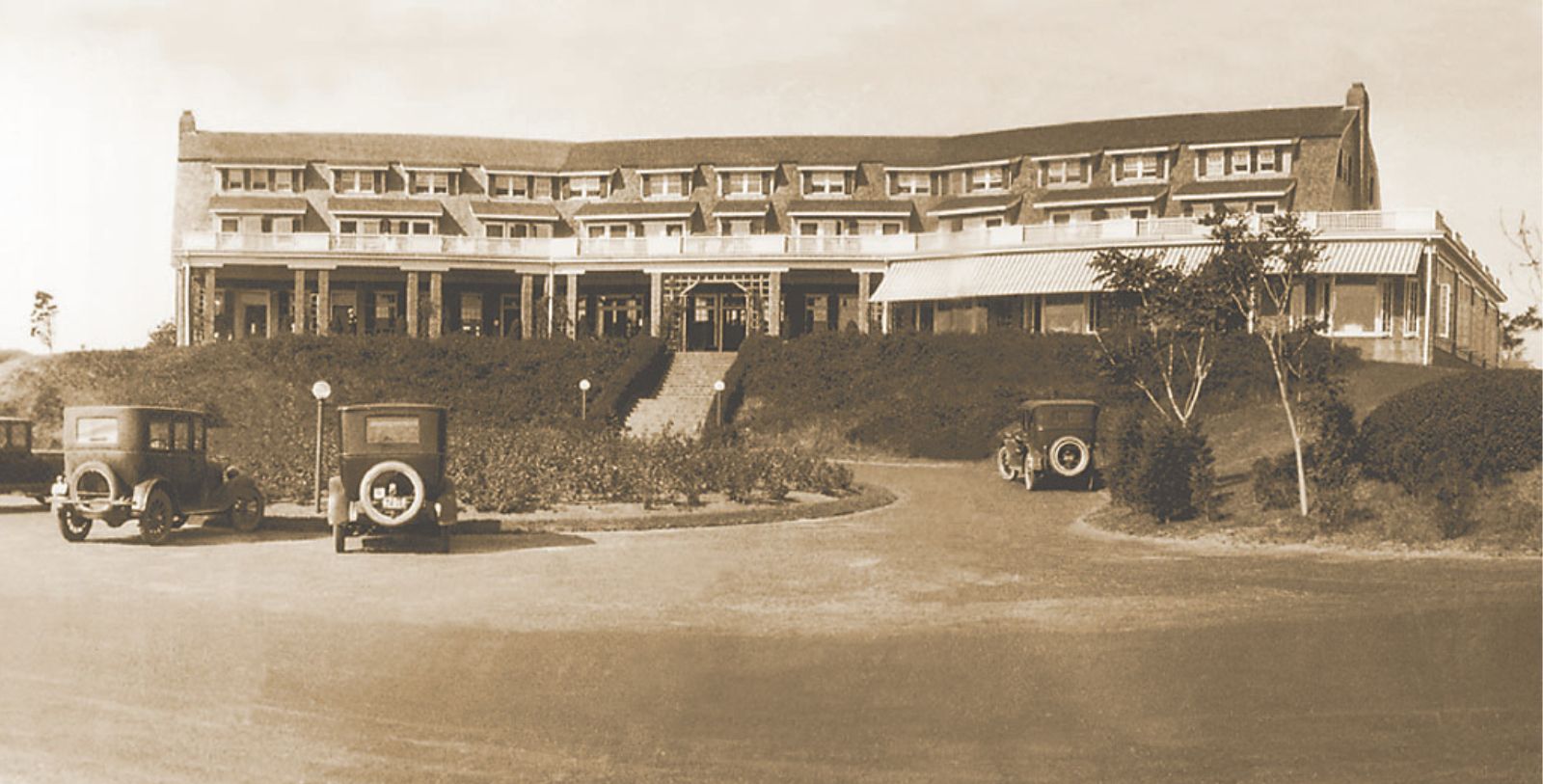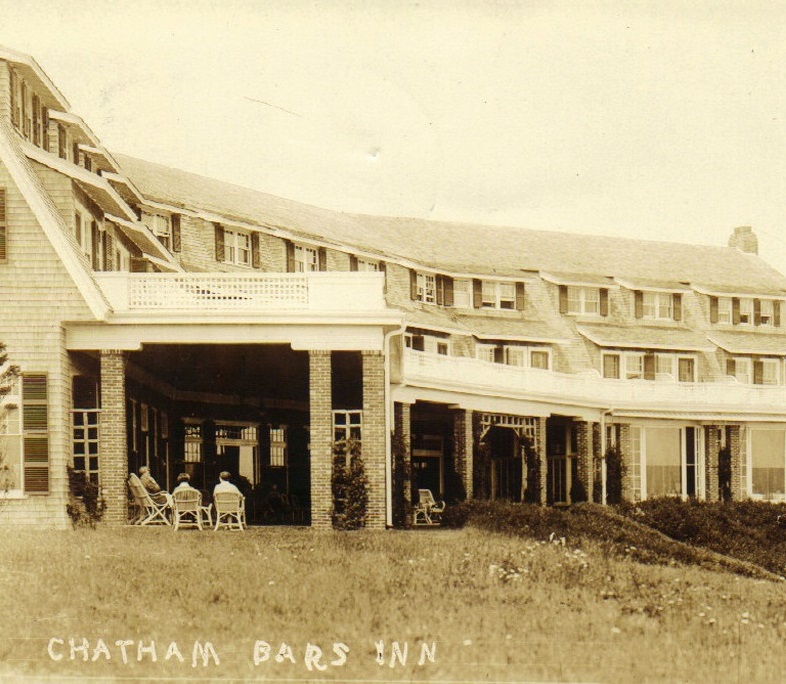Receive for Free - Discover & Explore eNewsletter monthly with advance notice of special offers, packages, and insider savings from 10% - 30% off Best Available Rates at selected hotels.
history
Chatham Bars Inn has hosted many illustrious guests over the years, including the likes of William Rockefeller Jr., Henry Ford, Henry Morgenthau Jr., and Queen Juliana of the Netherlands.
Chatham Bars Inn, a member of Historic Hotels of America since 2020, dates back to 1914.
VIEW TIMELINEA member of Historic Hotels of America in 2020, The Chatham Bars Inn has been a fixture in New England for more than a century. This brilliant holiday destination originally opened thanks to the efforts of Bostonian stockbroker Charles Ashely Hardy. Gathering a group of likeminded investors together, Hardy pushed for the creation of an exclusive vacation retreat in the heart of Cape Cod. Yet, the effort to create the Chatham Bars Inn was not without its risks. The region had only begun to emerge as a luxurious hotspot for tourists around America, and it was incredibly short of exciting cultural attractions that could entertain people for days at a time. But Hardy knew the cape well, for he had traveled frequently to the area on hunting trips since his youth. Confident that others would share his passion for the cape, he encouraged his fellow investors to create a rustic hunting lodge in the quaint fishing village of Chatham. Despite its official designation, Hardy spared no expense in constructing the building. He specifically designed the structure in the popular style of New England “Shingle” architecture, which gave the location its iconic eloquence and grandeur. Taking several months to complete, the “Chatham Bars Inn” debuted for the first time in 1914. Hardy’s stunning destination overlooked the tranquil waters of Aunt Lydia’s Cove, as well as the picturesque scenery offered by nearby Tern Island. Guests marveled at the soundproofed guestroom, as well as private bathrooms equipped with both fresh and saltwater tubs. A magnificent nine-hole golf course awaited them, as did a series of upscale tennis courts. Patrons also participated in various kinds of outdoor activities, ranging from hunting in the neighboring wilderness to sailing in nearby Pleasant Bay.
A tragic hunting accident claimed Hardy’s life in 1924, but his legacy would remain imprinted upon the business for years to come. The new owners of the lodge—an organization called the “Chatham Associates”—maintained the standards set forth by Hardy and succeeded in transforming the building into a luxurious resort hotel. People from across the United States flocked to the Chatham Bars Inn in the decades that followed, including some of the most influential figures in the nation’s history. Among the powerful individuals to grace the inn with their presence were the likes of Henry Ford, William Rockefeller Jr., and Henry Morgenthau, Jr., who was Secretary of the Treasury during all four terms of Franklin Delano Roosevelt’s presidency. The Chatham Bars Inn had even entertained European royalty, too! In 1940, the German invasion of the Low Countries in the Second World War forced the Dutch Royal Family to flee into exile. Seeking refuge, Princess Juliana and her three daughters soon arrived at the Chatham Bars Inn. They subsequently used it as their summer home throughout the duration of the war. (Juliana eventually became “Queen of the Netherlands” in 1948, a title she held until her abdication in 1980.)
By the middle of the century, the hotel’s prosperity had continued unabated, even as Edwin McMullen and his wife, Ursula, acquired the location in 1953. They subsequently succeeded in preserving the impressive standards created by their forebearers. Yet, the pair decided to sell the Chatham Bars Inn to William Langelier and Alan Green, who converted the hotel into a year-round destination for the first time in its history. The Chatham Bars Inn had almost been open for close to a century when Richard Cohen of Capital Properties acquired the location in 2006. Cohen had a brilliant vision for the hotel, desiring to elevate its prestige to the world stage. He invested $100 million into completely renovating the structure, leaving no area of the building untouched. Every guestroom inside the hotels’ main building were reconstructed to offer the best in modern comfort, while each cottage was redesigned from scratch. All of the restaurants and public spaces received a much-needed facelift, as well. But Cohen endeavored to protect the hotel’s wonderful architecture, ensuring that its historical character would endure for generations. When the work finally came to a conclusion a few years later, the Chatham Bars Inn debuted as Cape Cod’s most exclusive retreat. Since its grand reopening, the Chatham Bars Inn has received praise from throughout the travel industry, with the likes of Travel & Leisure and Boston Magazine declaring it one of the best resorts in the world. Truly few places are better for a memorable vacation experience in Cape Cod than the historic Chatham Bars Inn.
-
About the Location +
For centuries, the location of present-day Chatham was inhabited by the Nauset, specifically a tribe known as the “Monomoyick.” French explorer Samuel de Champlain was perhaps the first European to make direct contact with the Monomoyick, landing on the shoreline in 1606. Champlain recorded his interactions with the natives, calling the area “Port Fortuné.” (Relations soured between the two parties, however, and Champlain had to head back to his fleet.) The Monomoyicks remained in relative isolation until English settlers began near their land some five decades after Champlain’s arrival. In fact, one Englishmen named William Nickerson attempted to purchased some four square miles of territory from the Monomoyicks. (He specifically presented a sachem of the Monomoyicks, Mataquason, with a scallop, ten coats, six kettles, twelve axes, twelve hoes, twelve knives, forty shillings in wampum, a hat, and twelve shillings in coins.) But lengthy litigation proceedings with Plymouth Colony officials delayed the finalization of Nickerson’s deal for 12 years. Finally in 1664, Nickerson and handful of families from elsewhere in Cape Cod traveled to the site, erecting a few rudimentary cabins in the vicinity of a small cove. Nickerson’s community remained relatively small during the first 100 years of its existence, as only about 150 people lived in the region by the late 1690s. A huge impediment to its settlement was its lack of arable soil. Most of the residents struggled to grow various crops, specifically rye, wheat, tobacco, and corn. Corn proved to be the easiest to cultivate, even functioning as currency for a brief period of time.
Still, enough people lived in the community to hire both a preacher, as well as a schoolteacher. By 1712, the residents were successful in petitioning colonial officials in Boston for the creation of a town charter. (Plymouth Colony had been absorbed into the neighboring Massachusetts Bay Colony in 1691.) Christening the locale as “Chatham,” its inhabitants gradually began to embrace fishing, shipping, and commercial shipbuilding as an alternative to agriculture. The town’s primary exports to markets beyond New England included mackerel, halibut, and of course, cod, which its fisherman acquired directly from the Great Banks. Whaling, in particular, became an immensely popular trade, as did the practice of collecting vats of evaporated sea salt. Yet, continuous colonial wars with France significantly curtailed the maritime activities of those living in Chatham, as French pirates often assaulted the numerous vessels that left the town’s harbor. It was not until after the American Revolution that Chatham firmly established itself as one of Cape Cod’s most preeminent commercial ports. The town was filled with many mariners, some of whom regularly traveled to far off places in Africa and Asia. To aid the locals in their maritime trade, President Thomas Jefferson commissioned the creation of the Chatham Lighthouse in 1808. Originally consisting of two towers, it would go on to guide sailors through Chatham’s harbor for the better part of three centuries. (Other lighthouse would appear over the course of the 19th century, including the now-defunct Stage Harbor Lighthouse on Harding Beach.)
But word eventually spread to mainland Massachusetts of Chatham’s idyllic coastal setting, attracting scores of vacationers from Boston that were eager to escape the tumult of city life. The debut of the region’s first railroad in 1887 enabled even greater numbers of visitors to travel out to the area, giving rise to a profitable tourism industry that greatly supplemented the activities of the local maritime economy. Over the next few decades, entrepreneurial businessmen began erecting their own lodgings to address the influx, such as the Chatham Bars Inn in 1914. By the middle of the 1920s, Chatham had eight separate hotels within its borders. Close to 1,000 dwellings resided in the town at that point, as well, of which nearly half were seasonal cottages. Chatham built upon its prestige as a vacation hotspot, evolving into a premier resort community in the years following World War II. Many new facilities debuted, including various golf courses, yachting groups, and beach clubs. At the dawn of the 21st century, the town was hosting anywhere between 20,000 and 30,000 individuals every year! Today, Chatham remains an incredibly popular holiday retreat, filled with all kinds of exciting attractions to experience. In addition to being listed on the U.S. National Register of Historic Places, its downtown has numerous shops and restaurants to visit. Numerous historical landmarks are also located throughout the community, such as the Chatham Lighthouse, the Chatham Windmill, and the Atwood Museum. Chatham is also home to three amazing wildlife preserves—the Tern Island Wildlife Sanctuary, the Monomoy Island Wildlife Sanctuary, and a portion of the Cape Cod National Seashore.
-
About the Architecture +
When Charles Ashley Hardy originally constructed the Chatham Bars Inn as a quaint hunting lodge, he used the wonderful design principles of Shingle-style architecture as the source of his inspiration. Popular throughout New England at the height of the Gilded Age, Shingle architecture was born out of an immense regional interest to preserve colonial American culture. This desire specifically manifested in the aftermath of the Centennial Exposition if 1876, in which several of its exhibits celebrated the history of the nation’s origin story. Those throughout New England felt that the style of Shingle architecture best represented the simplistic aesthetics of British American architecture that was perceived as a humble alternative to the popular Eastlake and Queen Anne architectural forms that predominated across the rest of the country at the time. In stark contrast to those aforementioned styles, Shingle architecture specifically eschewed ostentatious decorations for complex shapes constructed with modest materials. Cedar shingling became the most prominent kind, giving rise to the practice of referring to the form as “Shingle” architecture. The shingling was applied across the entire structure from the roof to the walls. Architects typically stained or painted the material, even allowing it to weather natural in some cases. What few decorative elements that did appear throughout the structure tended to emphasize asymmetrical layout of each Shingle-style building, as a means of making it appear more rustic and authentic. But Shingle style did borrow some architectural elements from its fellow Victorian-era architecture. Great Palladian windows often appeared throughout the façade, while grand stone porches with beautiful columns occasionally served as the primary entrance point. On several occasions, architects would also include gables onto the roofs of some houses, as well as some small towers that blended in seamlessly with the overall design. Given the informality of Single architecture, it usually appeared only on residential structures. Yet, the style was also used to construct a few seaside resorts across New England, specifically along the coastlines of Long Island Sound and Cape Cod.
-
Famous Historic Guests +
Henry Ford, founder of the Ford Motor Company and creator of the historic Model T.
William Rockefeller Jr., co-founder of Standard Oil alongside his brother, John Davison.
Henry Morgenthau Jr., 52nd United States Secretary of the Treasury.
Queen Juliana of the Netherlands (1948 – 1980)
-
Film, TV and Media Connections +
The Finest Hours (2015)




































